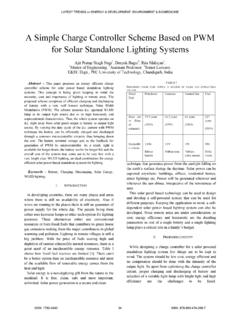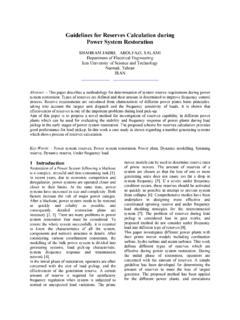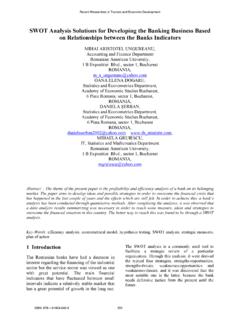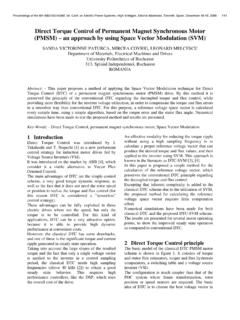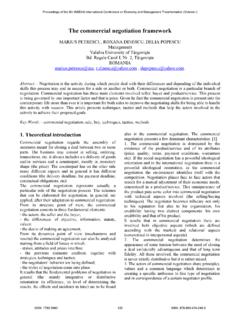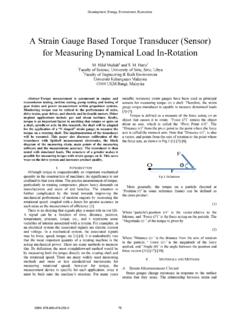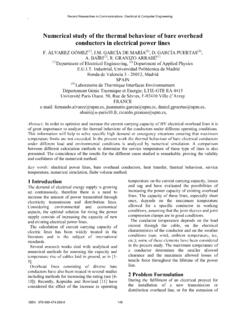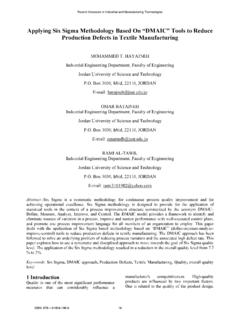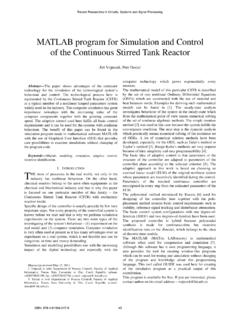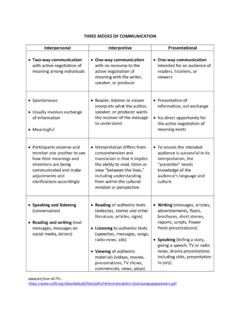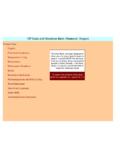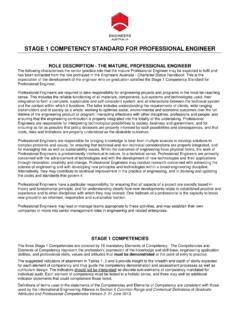Transcription of Communication cycle: Definition, process, models and …
1 Communication cycle : definition , process , models and examples PROFESSOR JOHN VELENTZAS, DR. GEORGIA BRONI Technological Institute of Western Macedonia Greece Abstract: Communication is the act of conveying information for the purpose of creating a shared under-standing. It's something that humans do every day. In other words, Communication is the activity of conveying information through the exchange of thoughts, messages, or information, as by speech, visuals, signals, writing, or behaviour. Pragmatics defines Communication as any sign-mediated interaction that follows combinatorial, context-specific and content-coherent rules. Key-words: Communication , information, linguistic, non-linguistic forms, sender, message, recipient, re-ceivers attitude, psychological noise, diagonal Communication . 1.
2 Introduction: The definition of Communication The term " Communication " has been derived from the Latin "communis," that means "common"1. Thus "to communicate" means "to make common" or "to make known", "to share" and includes verbal, non-verbal and electronic means of human interac-tion. Scholars who study Communication analyze the development of Communication skills in humans and theorize about how Communication can be made more effective. It is the meaningful exchange of information be-tween two or a group of people. Communicative competence designates the capability to install inter-subjective interactions, which means that communi-cation is an inherent social interaction2. One definition of Communication is "any act by which one person gives to or receives from another person information about that person's needs, de-sires, perceptions, knowledge, or affective states.
3 Communication may be intentional or unintentional, may involve conventional or unconventional sig-nals, may take linguistic or non-linguistic forms, and may occur through spoken or other modes."3 This act of making common and known is car-ried out through exchange of thoughts, ideas or the like. The exchange of thoughts and ideas can be had by gestures, signs, signals, speech or writing. People are said to be in Communication when they discuss some matter, or when they talk on telephone, or when they exchange information through letters. Basically, Communication is sharing information, whether in writing or orally4. Recent Advances in Financial Planning and Product DevelopmentISBN: 978-1-61804-261-3117 Humans convey information through a variety of methods: speaking, telephones, email, blogs, TV, art, hand gestures, facial expressions, body language and even social contexts5.
4 Communication can oc-cur instantaneously in closed, intimate settings or over great periods of time in large public forums, like the Internet. However, all forms of communica-tion require the same basic elements: a speaker or sender of information, a message, and an audience or recipient. The sender and recipient must also share a common language or means of understand-ing each other for Communication to be successful. As such, a study of Communication often examines the development and structure of language, includ-ing the mathematical languages used in computer programming. The act of communicating draws on several in-terpersonal and intrapersonal skills. These include speaking, listening, observing, questioning, process -ing, analyzing and evaluating.
5 Recipients of a mes-sage must be able to identify the sender's intent, take into account the message's context, resolve any mis-understandings, accurately decode the information and decide how to act on it. Such skills are essential to learning, forming healthy relationships, creating a sense of community and achieving success in the workplace. As a field of study, Communication spans a broad, rich array of subjects, including sociology, psychology, philosophy, political science, linguis-tics, history, literature, criticism and rhetoric. Al-though much of the field's subject matter is theoreti-cal in nature, Communication studies have proven applicable to business, film, theatre, composition, advertising, education, foreign policy and computer science. In today's globalized, media-driven world, com-munication studies have become more relevant and exciting than ever.
6 Web developers seek new, inven-tive ways to draw Internet users to their websites. Public policy writers debate society's most pressing issues. Through linguistics, computer scientists are developing programming languages that may some-day allow humans to interact directly with com-puters. Students who earn degrees in communica-tion often hold highly influential positions as jour-nalists, editors, university professors, public rela-tions officers, marketing consultants, speech writers, filmmakers, motivational speakers and political campaign managers. To communicate is to shape the world. Communication requires a sender, a message, and a recipient, although the receiver doesn't have to be present or aware of the sender's intent to commu-nicate at the time of Communication ; thus communi-cation can occur across vast distances in time and space.
7 Communication requires that the communi-cating parties share an area of communicative com-monality6. The Communication process is complete once the receiver has understood the message of the sender7. Language issues and Cultural Differences: the receiver(s) may not (fully) understand the language used by the transmitter. This may occur if the transmitter's language is foreign to the receiver. There may also be language problems (that the Communication process ) if the message contains technical information and the receiver's is not famil-iar with the technical terms used. Cultural differ-ences created by an individual's background and ex-perience affect their perception of the world. Such cultural differences may affect the interpretation (decoding) of the message sent8. Environmental issues: If the environment that the transmitter or receiver are in, is noisy and full of sound, the sounds may prevent the message being fully understood.
8 Background noise is often created by colleagues or machinery9. Channel issues: If the channel used to transfer the information is poor it may prevent all or some of the information being transferred. Examples include a faulty fax machine, a crackling phone, handwriting that cannot be read or in the case of oral messages incorrect facial gestures. Receivers Attitude and behaviour: If the re-ceiver(s) is not interested in the message (or unable to give their full attention to decoding) this may re-duce the amount of information received or the ac-curacy of the information transmitted to them. Simi-larly the receiver(s) may misinterpret the message Recent Advances in Financial Planning and Product DevelopmentISBN: 978-1-61804-261-3118 by "jumping to conclusions" or reading the message in a manner that suits their own interests/objectives and distort the true meaning of the message10.
9 Transmission journey: steps in the message. If the message is complicated or there are lots of steps taken to transfer the message it may affect the accuracy or interpretation11. Comparing with the leaky bucket if the leaky bucket has to carry water over a longer distance more water will probably lost than if the journey was shorter. 2. interpersonal Communication This is defined as Communication between two or more people and involves the transfer of informa-tion (or message) from one person to the other(s). The person transferring the information is called the sender or transmitter. The people receiving the mes-sage are known as receivers. The transmitter will need to send the information in a format that the re-ceiver(s) will understand. Converting the informa-tion into a format that the receivers will understand is known as Encoding.
10 Messages can be encoded into a variety of for-mats oral, written or visual. After encoding the mes-sage is transferred via a medium called a channel, for example a letter, fax, phone call, or e-mail. After transference the information will need to be inter-preted by the receiver. This process of interpretation is known as decoding. Finally the receiver will send a message back to the transmitter confirming whether the information sent has been understood. This back check is known as feedback12. 3. Internal / Organisational Com-munication This is Communication that takes place within (or across) an organisation. In addition to the usual face to face, telephone, fax or mail; modern organisa-tions may use technology to communicate inter-nally. Technology may be used for e-mails or a linked internal Communication system such as the intranet which is an internet system designed solely for use by those working for the organisation13.
